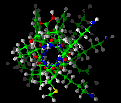 begin
begin begin
begin Jump to Description or
Examples; explanation of how
commands are documented.
Jump to Description or
Examples; explanation of how
commands are documented.
Keyword Values Default Meaning
coord*inate string run_name.car Name of coordinate data file. If none or car given, defaults to run_name.car. topol*ogy string run_name.mdf Name of molecular data file that or mdf defines connections, etc. If none given, defaults to run_name.mdf. forcef*ield string $FORCEFIELD Name of forcefield file. If none given, defaults to value of the $FORCEFIELD environment variable.
 Jump to Syntax or
Examples
Jump to Syntax or
ExamplesThe begin command is the first Discover command to be executed in the input file. It reads in the molecular system and the forcefield parameters. It does not set up the energy expression or the nonbond list. This is done the first time an energy calculation is requested (e.g., by a minimize command).
The typical use of the begin command does not specify any filenames. The molecular data are then picked up from the .car and .mdf files corresponding to the current run, and the forcefield is specified by the environmental variable $FORCEFIELD (same as for the Insight program).
 Jump to Syntax or
Description
Jump to Syntax or
Description
beginThis example of the begin command uses the default molecular data and forcefield file assignments.
begin forcefield = cvffThis example of the begin command uses the default molecular data files but explicitly reads the CVFF forcefield.
 Main
access page
Main
access page  Advanced-Use access.
Advanced-Use access.
 List of BTCL commands
List of BTCL commands
 atomMovability command
atomMovability command
 cellParameter command
cellParameter command
Copyright Biosym/MSI